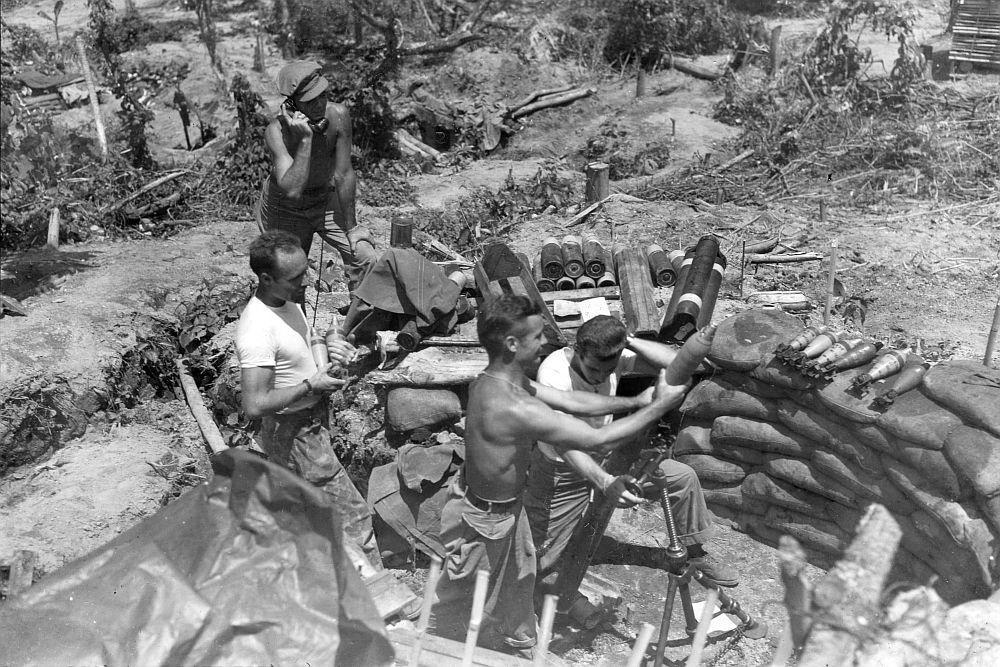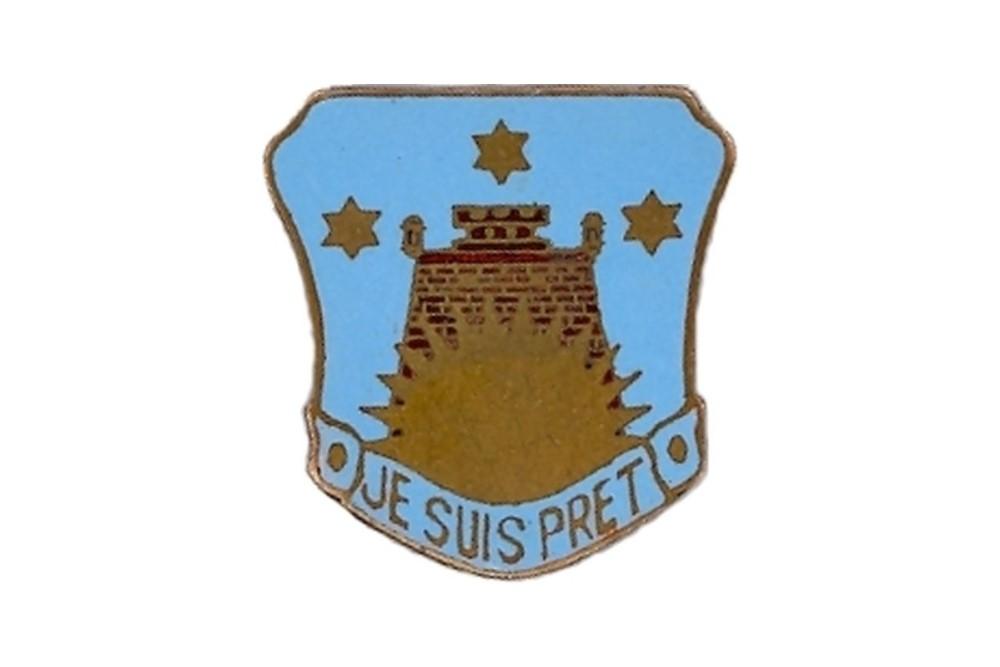Introduction
The 164th Infantry Regiment emerged from the North Dakota Army National Guard. During the First World War, the regiment was mainly deployed in France as a second-line training and supply unit. The regiment served in the battle in the South Pacific during the Second World War as part of the 23rd Infantry Division "Americal".
The 164th Infantry Regiment took part in the battle in Guadalcanal from October 13, 1942, where it was deployed as the vanguard of its division in order to reinforce the 1st Marine Division.
After the battle on Guadalcanal the regiment was withdrawn to Fiji for restructuring, after which it fought in the battles on Bougainville and the Philippines.
Definitielijst
- First World War
- Took place from 1914 till 1918 and is also named The Great War. The conflict started because of increased nationalism, militarism and neo-colonialism in Europe. Two alliances battled one another during the 4-year war, which after a dynamic start, resulted into static trench warfare. The belligerents were the Triple Alliance (consisting of Great-Britain, France, and Russia; later enlarged by Italy and the USA, amongst others) on the one hand and the Central Powers (consisting of Germany, Austria-Hungary, Bulgaria and the Ottoman empire) on the other hand. The war was characterized by the huge number of casualties and the use of many new weapons (flamethrowers, aircraft, poison gas, tanks). The war ended in 1918 when Germany and its allies surrendered unconditionally.
- Infantry
- Foot soldiers of a given army.
- Regiment
- Part of a division. A division divided into a number of regiments. In the army traditionally the name of the major organised unit of one type of weapon.
Origin
On December 8, 1906, Company E, First Infantry Regiment was established in Williston, North Dakota as a unit of the North Dakota Army National Guard. On June 18, 1916, the unit was placed under federal command and deployed at the border with Mexico[1].
After deactivation at Fort Snelling, Minnesota on February 14, 1917, Company E was reactivated on March 25, 1917, and drafted into federal command on August 5, 1917. On October 4, 1917, it was redesignated as Company E, 164th Infantry Regiment and assigned to the 41st Division. On October 5, the unit was formally designated as the 164th Infantry Regiment[2]. The regiment was supplemented with troops from the 2nd North Dakota Regiment and the Medical Detachment of the 3rd District of Columbia Infantry[3].
Definitielijst
- Infantry
- Foot soldiers of a given army.
- Regiment
- Part of a division. A division divided into a number of regiments. In the army traditionally the name of the major organised unit of one type of weapon.
First World War and the Interbellum
On December 14, 1917, the 164th sailed aboard USS Leviathan (SP-1326) to England where it arrived on December 24. Between December 31, 1917, and January 9, 1918, the regiment was sent to France, where it travelled via Le Havre to La Courtine, south of Paris. Instead of being deployed for active duty, the regiment was stripped of its soldiers, many of whom were dispatched to other front units. The remaining soldiers were reassigned to other locations to function as Supply and School units[4]. In this way the 164th Infantry Regiment fulfilled its task during the First World War. Although the regiment itself was not deployed as a combat unit, the regiment lost 278 men due to deployment elsewhere. After the end of the First World War, the unit was inactivated again on February 28, 1919, at Camp Dix, New Jersey[5].
On January 22, 1921, Company E, 1st Infantry Regiment was again drafted into federal service at Williston, North Dakota and placed under command of the 34th Division on October 21, 1921, as Company E, 164th Infantry Regiment. Around 1940, the unit again functioned as a regiment within the National Guard and was placed under federal command in Williston on February 10, 1941. For this purpose, it was withdrawn from the command structure of the 34th Infantry Division on December 8, 1941[6].
Definitielijst
- First World War
- Took place from 1914 till 1918 and is also named The Great War. The conflict started because of increased nationalism, militarism and neo-colonialism in Europe. Two alliances battled one another during the 4-year war, which after a dynamic start, resulted into static trench warfare. The belligerents were the Triple Alliance (consisting of Great-Britain, France, and Russia; later enlarged by Italy and the USA, amongst others) on the one hand and the Central Powers (consisting of Germany, Austria-Hungary, Bulgaria and the Ottoman empire) on the other hand. The war was characterized by the huge number of casualties and the use of many new weapons (flamethrowers, aircraft, poison gas, tanks). The war ended in 1918 when Germany and its allies surrendered unconditionally.
- Infantry
- Foot soldiers of a given army.
- regiment
- Part of a division. A division divided into a number of regiments. In the army traditionally the name of the major organised unit of one type of weapon.
Second World War
In January 1942, the 164th Infantry Regiment was sent to New Caledonia, where, together with the 182nd Infantry Regiment and the 132nd Infantry Regiment, it constituted the basis of the Americal Division, also known as the 23rd Infantry Division, formed on May 24, 1942. After combat training, the 164th Infantry Regiment arrived on Guadalcanal as the vanguard of its division on October 13, 1942, to reinforce the already present 1st Marine Division. With its combat actions on Guadalcanal, the 164th Infantry Regiment became the first American unit involved in offensive operations during the Second World War. After the Battle of Guadalcanal, the unit was reorganised in Fiji and its division subsequently took part in combat operations on Bougainville and the Philippines[7].

Mortar crew of the 164th Infantry Regiment on Bougainville, March 22, 1944. Source: US National Archives SC 190525
Definitielijst
- Infantry
- Foot soldiers of a given army.
- offensive
- Attack on a smaller or larger scale.
- Regiment
- Part of a division. A division divided into a number of regiments. In the army traditionally the name of the major organised unit of one type of weapon.
Post-war period
On November 24, 1945, the 164th Infantry Regiment was inactivated at Fort Lawton, Washington and formally released from its assignment to the 23rd Infantry Division on June 10, 1946, and assigned on paper to the 47th Infantry Division. On May 1, 1947, the regiment was reorganised and drafted as Company E, 164th Infantry Regiment at Williston. On January 16, 1951, it was again placed under federal command but inactivated again on December 2, 1954. It was then federally listed as Company C, 164th Infantry Regiment[8].
The regimental insignia consists of a light blue shield with a Spanish castle placed between three six-pointed stars. A setting sun is depicted in front of the castle. Below the shield is the text "JE SUIS PRET" (I Am Ready). The shield was originally that of the 142nd Engineer Battalion with the Spanish castle symbolising their participation in the Spanish-American War. The three stars symbolise participation in the suppression of the Philippine rebellion and the sun symbolises its participation in the 41st Division during the First World War. The shield was approved for use by the 164th Infantry Regiment on January 11, 1933, and was transferred back to the 142nd Engineer Battalion on May 8, 1956. On November 6, 1997, it was reassigned to the 164th Infantry Regiment[9].
Awards to members of the 164th Infantry Regiment of the 23rd Infantry Division
Definitielijst
- First World War
- Took place from 1914 till 1918 and is also named The Great War. The conflict started because of increased nationalism, militarism and neo-colonialism in Europe. Two alliances battled one another during the 4-year war, which after a dynamic start, resulted into static trench warfare. The belligerents were the Triple Alliance (consisting of Great-Britain, France, and Russia; later enlarged by Italy and the USA, amongst others) on the one hand and the Central Powers (consisting of Germany, Austria-Hungary, Bulgaria and the Ottoman empire) on the other hand. The war was characterized by the huge number of casualties and the use of many new weapons (flamethrowers, aircraft, poison gas, tanks). The war ended in 1918 when Germany and its allies surrendered unconditionally.
- Infantry
- Foot soldiers of a given army.
- Regiment
- Part of a division. A division divided into a number of regiments. In the army traditionally the name of the major organised unit of one type of weapon.
Commanders
| Chain of command |
||
| Commanding Officer: |
||
| Colonel John Fraine L.R. Baird Colonel Earle E. Sarles Colonel Bryant E. Moore Colonel Crump Garvin Colonel William James Mahoney |
1917 1931-1941 1941 15 september 1942 juni 1943 april 1944 |
|
| Executive Officer: |
||
| Lieutenant Colonel T.H. Tharalson |
1917 |
|
Organizational structure
| Organizational structure |
||
| Headquarters Company: |
||
| Commanding Officer: Captain T.S. Henry (1917) |
||
| Supply Company: |
||
| Commanding Officer: Captain Manville Sprague (1917) |
||
| Medical Detachment: |
||
| Commanding Officer: Major Frank E. Wheelon (1917) |
||
| Machine Gun Company: |
||
| Commanding Officer: Captain L.L Eckman (1917) |
||
| 1st Battalion: |
||
| Commanding Officer: Major Frank S. Henry (1917) |
||
| Headquarters Company |
Commanding Officer: |
|
| A Company |
Commanding Officer: Captain Millard C. Lawson (1917) |
|
| B Company |
Commanding Officer: Captain Charles L. Wheeler (1917) |
|
| C Company |
Commanding Officer: Captain Charles L. Rouse (1917) |
|
| D Company |
Commanding Officer: Captain Thomas Lonnevik (1917) |
|
| 2nd Battalion |
||
| Commanding Officer: |
||
| Headquarters Company: |
Commanding Officer: |
|
| E Company |
Commanding Officer: Captain Frank Ross (1917) |
|
| F Company |
Commanding Officer: |
|
| G Company |
Commanding Officer: Captain David Richie (1917) |
|
| H Company |
Commanding Officer: Captain George Crawford (1917) |
|
| 3rd Battalion |
||
| Commanding Officer: Major Barney C. Boyd (1917) Lieutenant Colonel Robert K. Hall |
||
| Headquarters Company |
Commanding Officer: |
|
| Company I |
Commanding officer: Captain Thomas Thomsen (1917) |
|
| Company K |
Commanding Officer: Captain Harry E. Thomas (1917) Captain Ben Northridge |
|
| Company L |
Commanding Officer: |
|
| Company M |
Commanding Officer: Captain Charles E. Cook (1917) |
|
Definitielijst
- Machine Gun
- Machine gun, an automatic heavy quick firearm.
Assignments
| Assigned to: |
||
| 41st Division |
October 4, 1917 – February 28, 1919 |
|
| 34th Division |
October 21, 1921 – December 8, 1941 |
|
| Americal Division (23rd Infantry Division) |
January 1942 – June 10, 1946 |
|
| 47th Infantry Division |
June 10, 1946 – May 1, 1947 |
|
Definitielijst
- Infantry
- Foot soldiers of a given army.
Campaigns
| Campaign locations: |
||
| 1917 - 1919 |
France |
|
| January 1942: |
New Caledonia |
|
| October 13, 1942: |
Guadalcanal |
|
| Bougainville |
||
| April 1945: |
Philippines |
|
Notes
- 164th Infantry Regiment, Wikipedia
- Cooper, 2005, pag.200
- Cooper, 2005, pag.201
- Cooper, 2005, pag.208
- 164th Infantry Regiment, Wikipedia
- 164th Infantry Regiment, Wikipedia
- Shoptaugh, 2010
- 164th Infantry Regiment, Wikipedia
- 164th Infantry Regiment, Wikipedia
Information
- Article by:
- Wilco Vermeer
- Translated by:
- Simon van der Meulen
- Published on:
- 18-01-2025
- Feedback?
- Send it!




